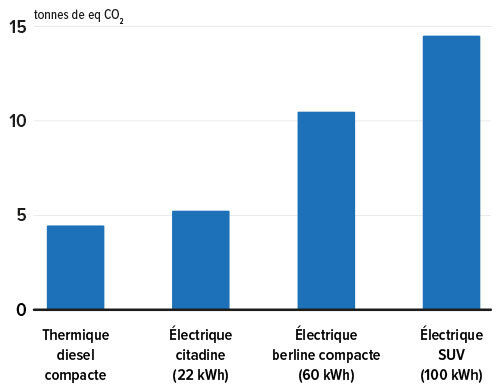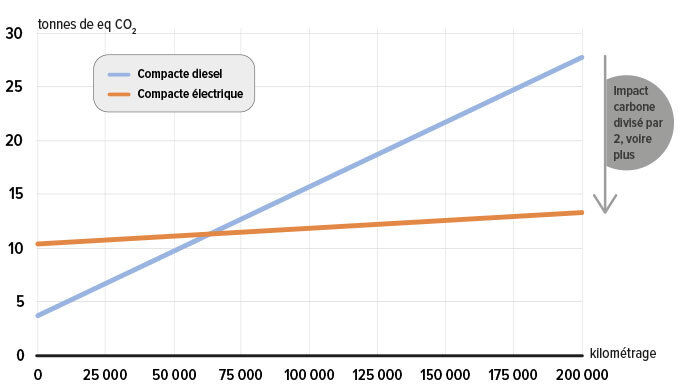Are they really ecological?
In an opinion published at the beginning of October 2022, Ademe (the French Agency for Ecological Transition) shows that electric vehicles have a much lower environmental impact than their thermal equivalent, but a real impact nonetheless. It therefore invites us to rethink their use.
“Green car”, “zero carbon” or “clean energy”: there is no shortage of slogans when it comes to promoting electric cars. These are excessively optimistic formulas compared to the reality of the environmental impact of these vehicles, as shown in a report by Ademe, the French Agency for Ecological Transition, published a few days before the Paris Motor Show. Today, electric engines represent barely 2% of the total fleet, but they account for 16% of sales. In view of the ban on the sale of combustion engines in 2035 and the achievement of carbon neutrality in 2050, the value of these vehicles should be clarified.
A starting debt
To begin with, an electric car is never “zero carbon”. Its production, and in particular that of its batteries, emits greenhouse gases (which are responsible for global warming). Even before it has driven a single kilometer, an electric car has a carbon “debt” of 5 to 15 tons of CO2 equivalent, depending on the model. This footprint is 2 to 3 times greater than that of an internal combustion equivalent, according to Ademe.
The manufacturing of an electric car has a higher carbon impact than that of a combustion car

Compensation for use
It is therefore with the use that the interest of the electric car appears. Logically, the electric car emits incomparably less CO2 than a thermal car that runs on gasoline. This is particularly true if the electricity production is decarbonized (from nuclear or renewable sources), which is rather the case in France, but not everywhere (if the electricity is produced by burning coal, the gain is obviously less). As the kilometers go by, the electric car therefore gains the advantage in terms of CO2 emissions. For a compact sedan, the tipping point is around 70,000 km.
An electric car emits much less CO2 than a thermal car

In the end, over its entire lifespan and considering that it will be driven 200,000 km, “an electric car driven in France has a carbon impact two to three times lower than that of a similar internal combustion model,” concludes Ademe. According to other estimates, this order of magnitude is even higher. If we take into account the carbon impact of the extraction of gasoline and its transport, the carbon impact of the thermal car is higher than current estimates. Conversely, if we take into account recent advances in battery production, the carbon impact of electric vehicle manufacturing is reduced. The NGO Transport et Environnement, which specializes in these issues and is financed by the European Climate Foundation, has made its own calculations. “Our own life-cycle analyses show a carbon impact five times lower for electric cars in France,” says Lucien Mathieu, director of the NGO’s French office.
Reduced air pollution
Greenhouse gas emissions are a major part of the environmental impact of vehicles, but not the only one. What about air pollution? In this respect, the advantage goes to electric motors, which do not emit any exhaust pollutants, thus avoiding the release of nitrogen oxides. These toxic gases are still a problem in several French cities, even though emissions from combustion engines have been greatly reduced thanks to catalytic converters. The balance sheet for particulate matter is also favourable, but less clearly. Although electric vehicles emit fewer particles related to brake pad wear, they still emit, and perhaps just as many, particles related to the abrasion of tires in contact with the road and the resuspension of those present on the ground. This is especially true since electric vehicles are heavier and have larger tires.
Reasonable battery
“The electrification of cars does not eliminate all the nuisances,” insists Ademe. To minimize them, the size, and therefore the weight, of electric vehicles and batteries must be questioned. Ademe sets a limit of 60 kWh for battery capacity, beyond which “the environmental interest is not guaranteed”. But the reason for choosing this threshold is not well argued. This type of battery is already substantial, offering a range of 450 km. It is therefore too big to replace a car dedicated to home-work trips, but may be insufficient to replace a thermal car driving several hundred kilometers per day. It is for these heavy drivers that the gain in carbon emissions over the life of the vehicle is the most important,” emphasizes Lucien Mathieu. The size must be adapted to the use. Current trends, with an average weight gain of 10 kg per year for cars over the past 30 years, go rather against this reasonable approach! The presentation of the future electric 4L, which is much longer, wider and heavier than its ancestor, shows the opposite of a sobriety approach.
Detach yourself from the model
However, it is necessary to work on sobriety, says Ademe. To cancel out the environmental impact, the use of electric vehicles is necessary, but not sufficient. We need to work on both “reducing travel needs” and “shifting to other means of mobility that have less impact than the individual car”: walking, cycling, public transport, carpooling, carsharing, very light vehicles, etc. “Even electric cars are not sustainable vehicles and do not solve the problems of space occupation, accidents and sedentary lifestyles,” said the Study and Research Group on Intermediate Vehicles (Gervi) in an opinion piece. To model the use of electric cars on their predecessors is to reproduce a number of errors or to create new ones. Recharging a battery as quickly as one fills up with fuel, in two minutes, would represent a power demand equivalent to that of 1,500 households simultaneously!


